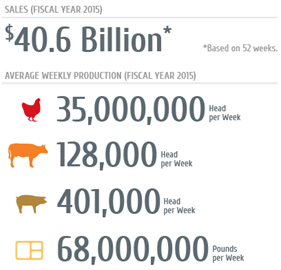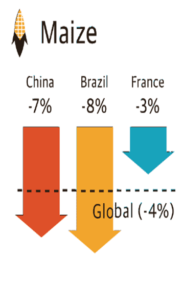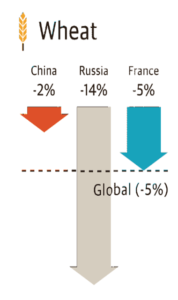In the ring with Tyson

Can the super heavyweight food producer see eye-to-eye with climate change?
Tyson Foods, one of the world’s largest producers of meat and poultry, is likely to be significantly affected by climate change. Food production and livestock may not necessarily be the first thing that pops into our heads when we think about climate change but if you haven’t already, let’s pause and consider it for a moment. An industry or company can be affected by climate change in two ways; those that contribute to the onset of climate change, with the potential for negative impact due to consumer sentiment and/or regulation, or those that will have their operating performance squeezed due to increasing inefficiencies induced by climate change. I believe Tyson Foods is in the precarious position of straddling both sides of the equation.
the world’s largest producers of meat and poultry, is likely to be significantly affected by climate change. Food production and livestock may not necessarily be the first thing that pops into our heads when we think about climate change but if you haven’t already, let’s pause and consider it for a moment. An industry or company can be affected by climate change in two ways; those that contribute to the onset of climate change, with the potential for negative impact due to consumer sentiment and/or regulation, or those that will have their operating performance squeezed due to increasing inefficiencies induced by climate change. I believe Tyson Foods is in the precarious position of straddling both sides of the equation.
While there is debate around the actual impact of the livestock supply chain on GHG emissions with estimates ranging from 18%1 to a staggering 51%2, the impact appears to be significant. In fact, even 18% is higher than the entire transportation sector’s emissions. With human consumption of livestock still increasing per capita and the global population forecasted to reach 9.6 billion by 20503, this issue is only expected to become more exacerbated. If unchecked, this trend could lead to an estimated 80% increase in global livestock GHG emissions by 20504.

 On the other side, Tyson Foods is also in the unenviable position of dominating an industry where climate change is lower production yields and therefore operating performance. Rising temperatures and greater fluctuations in weather patterns are adversely affecting crop performance and consequently, livestock production for Tyson Foods5.
On the other side, Tyson Foods is also in the unenviable position of dominating an industry where climate change is lower production yields and therefore operating performance. Rising temperatures and greater fluctuations in weather patterns are adversely affecting crop performance and consequently, livestock production for Tyson Foods5.
Tyson Foods has taken some steps to address the implications of climate change6. To-date, these can be categorized into three buckets:
- Monitoring and addressing the sustainability materiality of their operations;
- Participating in partnerships and initiatives targeting sustainable agricultural; and
- Investing in companies seeking to generate sustainable sources of food
Firstly, Tyson produces an annual sustainability materiality assessment, although it was “…not meant to be a comprehensive review of all sustainability risks and opportunities.” 6 While sustainable agriculture is one of six metrics covered, during 2013-15 Tyson managed to maintain stable levels of “GHG Intensity” and “Electricity Intensity” per pound of finished goods. However, “Energy Use Intensity” and “Fuel Intensity” per pound of finished product both increased.
Secondly, Tyson has become more active in sustainable agriculture partnerships and initiatives, including becoming a founding member of the U.S. Roundtable for Sustainable Beef, in March 20156 and announcing a partnership with The Nature Conservancy to support projects intended to conserve water quality, in July 20156.
Thirdly, Tyson has begun investing in more sustainable food sources, including a 5% stake in plant-based protein producer, Beyond Meat7. While some stakeholders from both sides of the table are concerned about this move, others see it as a step in the right direction. That is, for Tyson to move into more sustainable meat alternatives and to provide smaller meat alternatives (such as Beyond Meat) with the knowledge and connections needed to effectively scale their business.
Taking a step back from Tyson’s current activities, I think it’s worth drawing into focus the overarching goal – to ensure global food systems are both profitable and sustainable in the face of climate change. To achieve this, there are three outcomes that require intervention8:
- Increasing productivity sustainably;
- Enhancing the resilience of producers and supply chains; and
- Reducing emissions
While Tyson has made some initial commitments to address these factors, I believe much more can be done to make a more meaningful contribution to this critical mission.
Tyson can increase their commitment to the three initiatives already underway, for example, improving their GHG and Electricity Intensity, becoming an architect and beacon of sustainable agriculture globally, as well as increasing their investments in companies creating sustainable food alternatives.
In addition, I see four areas for Tyson to take additional steps, it can:
- Elevate the importance of sustainability within their company by introducing a Chief Sustainability Officer to their management team – a role that is currently void from their executive management;
- Help their supply chain partners to identify and implement more sustainable agricultural practices;
- Educate consumers on the processes and challenges of livestock production and the environmental impact of consuming different types of animal protein; and
- Champion global agricultural policy to ensure sustainability is incorporated into vertically integrated support programs to drive more sustainable supply chain
While these points may sound counter-intuitive (especially the third) as they are likely to negatively impact Tyson’s bottom line in the short-term, I feel they are necessary to curb the current trajectory of the food industry’ relationship with climate change. Education and timely and reliable data are core enablers of the effective allocation the world’s resources to ensure our food system can meet growing consumer demand profitably and sustainably.
Word count: 800
Footnotes
- Food and Agriculture Organization of the United Nations, 2006, “Livestock’s Long Shadow: Environmental Issues and Options”, ftp://ftp.fao.org/docrep/fao/010/ a0701e/a0701e03.pdf, accessed November 2016
- Goodland, R. and Anhang, J., 2009, “Livestock and Climate Change: What if the key actors in climate change were pigs, chickens and cows?”, Worldwatch November/December 2009, Worldwatch Institute, pp. 10–19
- United Nations, 2006, “World population projected to reach 9.6 billion by 2050 – UN report.” http://www.un.org/apps/news/story.asp?NewsID=45165#.WBv7f9Ur LIU, accessed November 2016
- United Nations, 2006, “Rearing cattle produces more greenhouse gases than driving cars, UN report warns”, http://www.un.org/apps/news/story.asp?newsID=20772#. WBv49tUrLIU, accessed November 2016
- Hererro et al., 2011, “Livestock and greenhouse gas emissions: The importance of getting the numbers right”, Animal Feed Science and Technology
- Tyson Foods, 2016, “Tyson Sustainability”, http://www.tysonsustainability.com/ about-this-report, accessed November 2016
- Chicago Sun Times, 2016, “Tyson invests in Beyond Meat, maker of meat substitute”, http://chicago.suntimes.com/news/tyson-buys-stake-in-maker-of-meat-substitute/, accessed November 2016
- Tilman, D, Clark, M, 2014. Global diets link environmental sustainability and human health. Nature, Volume 515, 518, 520, http://academic.regis.edu/MFRAN CO/Seminar%20in%20Biology%20research%20Literature/Papers/GobalDiets.pdf, accessed November 2016



Interesting article – I tend to agree with your recommended next steps. However, from reading what Tyson has done to date, they strike me as a company which is only paying lip service to the issue of climate change. Very little of what they have done would have added any cost to the business and it many of the steps seem to be publicly visible but without any clear link to a reduction in the amount of greenhouse gases produced. If anything, the amount of reports they seem to have produced probably increased their carbon footprint!
Ty – this a very interesting and well written article. Regarding your recommendations, and on that third bullet, I wanted to reinforce the consideration you highlighted around reducing short-term sales: indeed, I have never bought from Tyson since understanding their relative negative impact (beyond climate) across their overall value chain. That said, (a) I can afford to do so, which is simply not the case with most, and (b) I don’t think consumers like me necessarily want Tyson to die, for the major opportunities you pointed for Tyson to make a positive impact (although Cathal’s cynicism is more in-line with my personal sense of humor). Here’s what I think it would take for the majority of these newly-aware consumers that would stop buying Tyson to opt back in:
1. Tyson figures out the industry standard for negative impacts per dollar of customer money spent; I pick this denominator because while probably one of the hairier for Tyson to calculate, the clearest for the customer to understand what’s going on with his/her dollar.
2. Tyson keeps par (ideally beats) that industry standard – heck, if my dollar spent on Tyson had less negative impact than the more expensive stuff I’m buying now, count me in!
3. Tyson keeps ahead of that industry standard, because where they go, the market will go.
Obviously, this is an extremely high bar and very costly to implement. That said, I’ve already opted out of Tyson, and I would wager I’m not the only one 🙂
Ty – Great post and even greater title. I enjoyed your structural comparison between what Tyson is currently doing and what you suggest Tyson does going forward. I think your recommendations are thoughtful and practical. However, I wonder if Tyson should take greater risks for potential greater rewards in the future? A 5% stake in plant-based protein producer, Beyond Meat, is commendable; however, what would it look like if Tyson pivoted and put a significant stake (20-50%) in plant-based protein? I believe this is an interesting area to explore considering both the increase in vegetarians worldwide and the environmental impact from livestock.
Thanks for sharing this post, Ty! I was shocked to see Tyson invested in Beyond Meat. As a potential disruptor to Tyson’s meat business, I hope Tyson’s investment is not meant to thwart the startup’s efforts, but instead accelerate them. The impact of a carnivorous diet on the climate is a real issue and one that is rarely talked about. I wonder if we will see regulation in our lifetime that prices in the externalities associated with eating meat.
Thanks so much for this post. I love your comment about Tyson facing a double impact from climate change. It seems to me that the 2 biggest things they need to change are the methane emissions from raising livestock and the declining returns from unsustainable plant sources and feed. The case we read about Indigo highlights how many different ways companies are trying to create sustainable crops. Instead of investing in meat alternatives, Tyson should invest in companies creating better, more natural, more sustainable feed. They should also research methods for capturing methane output and recycling it into less dangerous GHG emissions.
Ty – Awesome post on Tyson and the food industry, as I didn’t realize it’s challenged on “both sides of the equation.” Playing management for a second, I’m most curious is how Tyson is thinking about consumer behavior shifting to more healthy options, and whether they could change their operations to adapt to more global friendly environment. Additionally, are there other types of foods other than chicken that they are moving towards to hedge their current product offering and global warming.
Thanks for the post!
Very interesting post, Ty. Thanks for sharing. I also wrote a post about the impact of the livestock industry on global gas emissions. If you have the chance, Cowspiracy is an interesting and relevant documentary on Netflix. I found it to be incredibly informative despite the somewhat cheesy-sounding name.
Definitely through provoking. Curious how the CSO role plays out at a place like Tyson. I’m more sympathetic with the CSO role where there’s a more proximate existential threat to the firm’s supply chain. It seems like Tyson understands its need for future investment, but is keeping its core business largely the same. I’m a little skeptical about how much a CSO could accomplish at Tyson, but I’m encouraged by your mention of the supply chain partner push. There could be a collective action problem where Tyson could be powerful.
Well said Ty. I once got advice that “the happiest fish were the ones that swam downstream.” This could not be more true for Tyson Foodsgiven the strategic advancements towards more sustainable procured foods. I think it would be foolish to believe that this is less than a movement. I believe that behaviors are slowly changing and that people will begin, or have begun asking about where their food comes from in a restaurant. It won’t be long until all o the chicken products in the market are called to answer the same scrutiny.
Great post, Ty! I definitely agree with the point about educating consumers. Having received a few environmental educational materials regarding poultry product in the US, I become more conscious of the impact of my food consumption on the environment and I grow to accept a higher price point more because of that. Another interesting thing as you mentioned is to join force with the supply chain partners. I was just reading the article about Burger King and its impact. It makes sense to create strategic partners between the meat provider and companies like Burger King to help make a positive impact on the environment together.